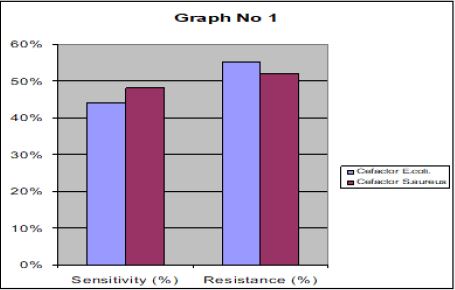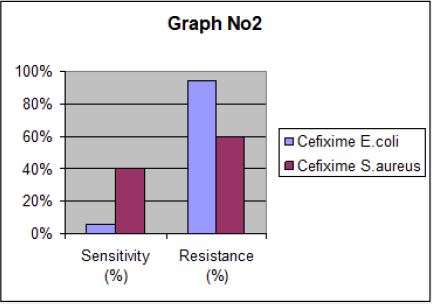Biography
Interests
Samiyah Tasleem1*, Sana Shamim2 & Syed Baqir Naqvi2
1Department of Microbiology, University of Karachi, Federal Urdu University of Arts, Science & Technology,
Karachi, Pakistan
2Department of Pharmaceutics, Faculty of Pharmacy, University of Karachi, Pakistan
*Correspondence to: Dr. Samiyah Tasleem, Department of Microbiology, University of Karachi, Federal Urdu University of Arts, Science & Technology, Karachi, Pakistan.
Copyright © 2018 Dr. Samiyah Tasleem, et al. This is an open access article distributed under the Creative Commons Attribution License, which permits unrestricted use, distribution, and reproduction in any medium, provided the original work is properly cited.
Abstract
Staphylococcus aureus and Escherichia coli are associated with variety of infections in our country. The developing resistance among these organisms against different antibiotics is a serious problem all over the world. Staphylococcus aureus is a major cause of hospital - acquired infections of surgical wounds and an infection associated with medical device Escherichia coli is opportunistic pathogens it is the most common cause of urinary infections, neonatal meningitis and diarrhoea.
During the present study 50 isolates of Staphylococcus aureus and 50 isolates of Escherichia coli has been collected from the different labs, of Karachi. The sensitivity pattern of these isolates was determined against cefixime and cefaclor using disc diffusion method and data was analyzed by using National Committee for Clinical Laboratory Standard (NCCLS).
Data indicated that the clinical isolates of Escherichia coli have exhibited 44% sensitivty, 56% resistance to cefaclor and Staphylococcus aureus has shown 48% sensitivity, 52% resistance to Cefaclor.
The clinical isolates of Escherichia coli have exhibited 6% sensitivity, 94% resistance to cefixme. Whereas Staphylococcus aureus has shown 40% sensitivity, 60% resistance to Cefixime.
Introduction
Staphylococcus aureus is a noteworthy bacterial human pathogen that causes a wide assortment of clinical signs. Diseases are regular both in network procured and also clinic obtained settings and treatment stays testing to oversee because of the rise of multi-medicate safe strains, for example, MRSA (Methicillin- Resistant Staphylococcus aureus). S. aureus is found in the earth and is likewise found in ordinary human greenery, situated on the skin and mucous layers (frequently the nasal region) of most solid people. S. aureus does not regularly cause disease on solid skin; in any case, on the off chance that it is permitted to enter the circulation system or interior tissues, these microscopic organisms may cause an assortment of conceivably genuine contaminations. Transmission is commonly from direct contact. Be that as it may, a few contaminations include other transmission techniques.
Staphylococcus aureus (including drug-resistant strains such as MRSA) are found on the skin and mucous membranes, and humans are the major reservoir for these organisms. It is estimated that up to half of all adults are colonized, and approximately 15% of the population persistently carry S. aureus in the anterior nares. Some populations tend to have higher rates of S. aureus colonization (up to 80%), such as health care workers, persons who use needles on a regular basis (i.e., diabetics and intravenous (IV) drug users), hospitalized patients, and immunocompromised individuals. S. aureus can be transmitted person-to-person by direct contact or by fomites.
Uncomplicated urinary tract infection (UTI) is a bacterial infection of the bladder and associated structures. These are patients with no structural abnormality and no comorbidities, such as diabetes, immune compromise, or pregnancy. Uncomplicated UTI is also known as cystitis or lower UTI. Escherichia coli is the most common organism in uncomplicated UTI by a large margin.
Cefaclor has a place with the group of anti-infection agents known as the Cephalosporins (cefalosporins). The cephalosporins are wide range anti-infection agents that are utilized for the treatment of septicemia, pneumonia, meningitis, biliary tract contaminations, peritonitis, and urinary tract diseases. The pharmacology of the cephalosporins is like that of the penicillins, discharge being primarily renal. Cephalosporins infiltrate the cerebrospinal liquid inadequately except if the meninges are aggravated; cefotaxime is a more reasonable cephalosporin than cefaclor for diseases of the focal sensory system, e.g. meningitis. Cefaclor is dynamic against numerous microbes, including both Gram-negative and Gram-positive creatures.
Cefixime is in the third era cephalosporin class of medications, an anti-infection valuable to treat various bacterial infections. This incorporates otitis media, strep throat, pneumonia, urinary tract contaminations, gonorrhea, and Lyme disease. For gonorrhea commonly just a single dosage is required. It works by upsetting the microscopic organisms’ cell divider bringing about its death.
Experiment
The present study was carried out to evaluate the sensitivity pattern of Cefaclor and Cefixime against 100
isolates of Staphylococcus aureus and Escherichia coli. for this purpose clinical isolates was determined by disc
diffusion method.
Diameter of the zone of inhibition around each disc was measured and they were interpreted as sensitive or resistant according to the zone of interpretive standards.
Result and Dissociation
The sensitivity of the mentioned drugs against 50 isolates of Escherichia coli, 50 isolates of Staphylococcus
aureus table 1 and graph 1- 2.



Staphylococcus auruse is a gram positive, cluster- forming coccus, non-motile, non-spore forming facultative anaerobes. It is normal flora of humans found on nasal passage, skin and mucous membrane. Pathogens of human cause a wide range of supportive infections, as well as food poisoning and toxic shock syndrome etc.
Escherichia coli are a Gram- negative coccus bacilli occurring singly or in pairs. It is facultative anaerobe with both fermentative and respiratory type of metabolism. It is a major facultative inhabitant of large intestine. Pathogenic Escherichia coli are associated with human diseases such as cholera, like diarrhoea, dysentery, urinary tract infections, septicemia and meningitis.
Organisms those are normally sensitive to the action of antibiotic some time s develop resistance. During present study the sensitivity pattern of cefaclor and cefixime against Escherichia coli and Staphylococcus aureus was determined. Cefaclor and Cefixime are very effective against Gram positive and Gram negative microorganism. They have wide coverage against Escherichia coli and Staphylococcus aureus. However, emerging microbial resistance of these organisms to antibiotics are now wide spread and possess a serious clinical treat.
Present study shows that Escherichia coli 44% sensitive and 56% resistance against Cefaclor whereas Staphylococcus aureus is 48% sensitive and 52% resistant.
Escherichia coli are 6% sensitive and 94% resistant to cefixime whereas S. aureus is 40% sensitive and 60% resistant.
The present result is in confirmation with the work of Machka K 1979 reported 46% sensitivity and 54% resistance of Escherichia coli to cefaclor [1].
Tomiyama M in 1995 showed elimination rate i.e. sensitivity in the patient treat with cefaclor were 83% for Staphylococcus aureus and for cefixime the sensitivity rate was 50% [2].
Elmanama AA et al in 2006 reported 42.2% resistance and 57% sensitivity of Escherichia toward cefaclor [3].
Fuchs et al in 1986 reported that Enterobacteriaceae were inhibited by lower concentration of cefixime than other B-lactams, including cefaclor, cefuroxime, amoxicillin and amoxicillin + clauvlanate. Being third generation cephalosporin cefixime is more effective than second generation cephalosporin but the members of the family Enterobacteriaceae susceptible to cefixime.
These results are not in confirmation with the work of Andeu A et al in 2005 reported susceptibility rate of E.coli was 95% to cefixime [4].
Preton Da in 1993 reported 90% susceptibility of E.coli to cefaclor [5]. Irvani et al in 1988 reported 92% eradication rate of E.coli with cefixime [6]. Asvanick K et al in 1998 repoted 91.4% sensitivity of E.coli to cefixime [7,8].
Conclusion
Hence cefixme and cefaclor were found to be moderately effective against different clinical isolates but
microorganism have started developing resistance to antibiotic by any of the following mechanism; selection,
mutation, phage, transduction and transference which is very alarming and it is essential that the drugs
should not be prescribed frequent unless other alternative available because once these organisms started
developing resistance to cephalosporin then we will be left with no other choice. The present study will be
helpful for the doctor and pharmacists in the selection of more rational antibiotics during treatment and
proper prescription of antibiotic doses and also in the minimization of microbial resistance to antibiotics.
Bibliography

Hi!
We're here to answer your questions!
Send us a message via Whatsapp, and we'll reply the moment we're available!